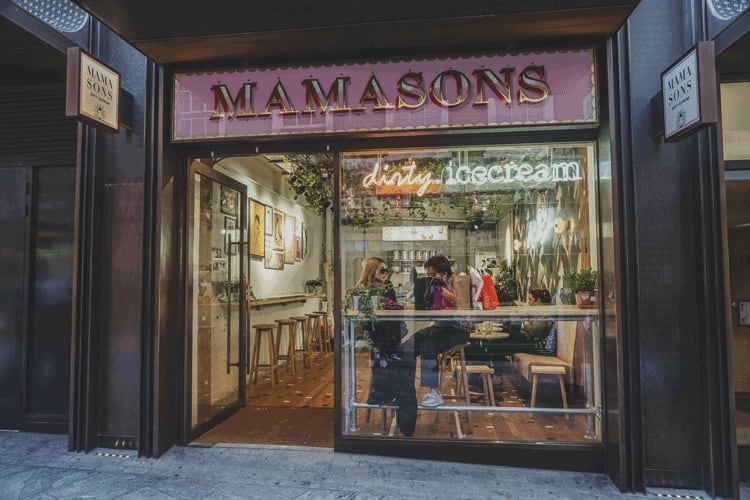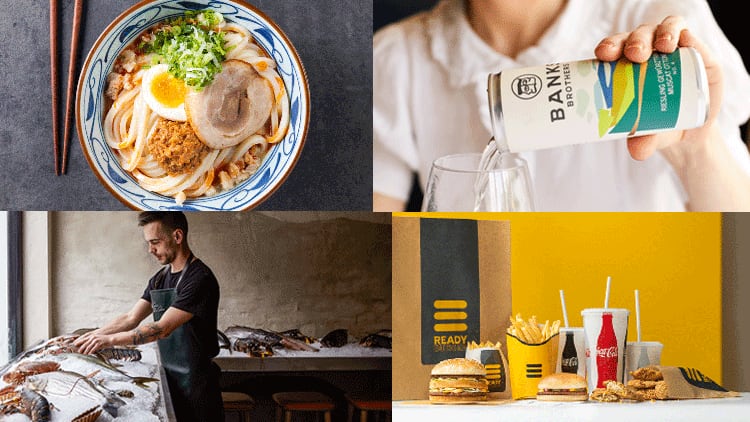If Rick Stein has Padstow, and Simon Rogan Cartmel, then Omar Shah and Florence Mae Maglanoc have their own mini fiefdom, albeit one not quite as glamorous as the Cornish and Lake District postcodes of their peers.
Over the past few years, the couple have steadily built an eclectic collection of restaurants in their local neighbourhood of Kentish Town, including a Filipino bakery, ice cream parlour, pan-Asian restaurant, fusion ramen bar, West African takeaway joint and Latin American and Caribbean restaurant and, more recently, have extended their reach into central London and beyond.
If you haven’t heard of Omar or Mae, or their Maginhawa restaurant group, it might be because Camden is not your regular stomping ground. But it’s more likely because, as a group, Maginhawa was only conceived in 2019 (and the past two years have been engulfed in a Covid fog) even though its more well-known brands have been around for a bit longer - and in one case 35 years.
Most famous of them is Mamasons, the Filipino ‘dirty ice cream’ brand that started life in Kentish Town in 2017 before opening a second venue in Chinatown in 2018 and which more recently opened a super-chic flagship site in London’s Westfield. With Mamasons the pair took an incredibly niche food, namely bright purple yam and cheese ice cream cones and sandwiches and catapulted them into the mainstream in a way no one at the time would have believed possible.
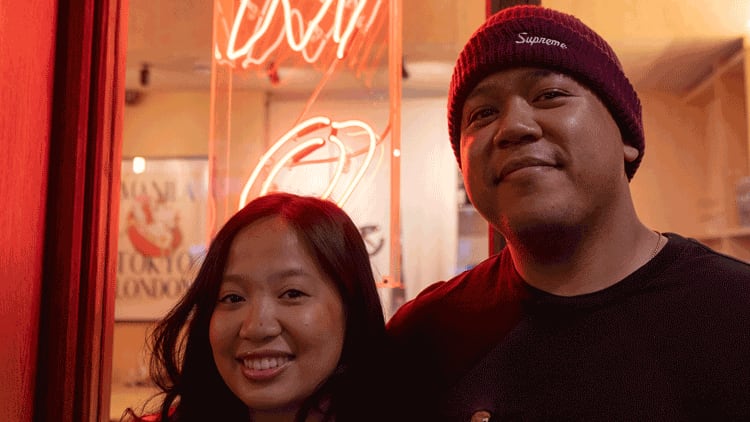
Keeping it in the family
The story of Maginhawa and its motley band of venues starts well before that, however, all the way back to 1987 in fact, with pan-Asian restaurant Bintang. Founded by Omar’s parents, Bintang took inspiration from his Bangladeshi father and Filipino mother serving a halal menu of Asian dishes alongside some Filipino ones. “My dad’s Muslim so it didn’t serve pork and the meat was halal,” says Omar. “There were not a lot of halal restaurants out there serving second generation Muslims, so it was different.”
It was at Bintang that Omar got his first taste of hospitality. Launched when he was only six years old by the time he was eight he was helping out in Bintang’s small kitchen and by 10 years old was taking orders out front. “My parents basically used me as child labour there,” he laughs. “Hospitality has been in my blood for a long time.”
School and subsequently university, where he studied for a degree in business finance, kept him out of restaurants for a while but when in 2007 the opportunity came up on a site next door to Bintang Omar finally took the leap proper into hospitality to open Guanabana, one of the first Latin Caribbean restaurants in London.
“It was next door to Bintang so I had to think of a totally different cuisine to do,” he says. “I had fallen in love with South American and Caribbean food and thought let’s do that. It was London’s first halal Caribbean restaurant.”
It was at Guanabana that Omar met Mae around six years ago. Mae, who had an art degree and who had studied graphics design and advertising also had a passion for food and it is their combined skills in the kitchen as well as a love of design on Mae’s side and for business on Omar’s that has helped mould the company into what it is today.
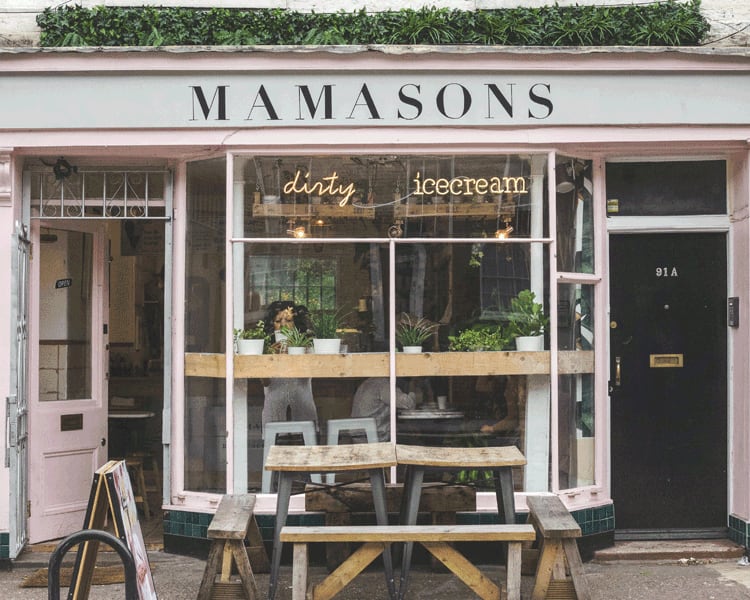
A Kentish Town empire
Unbeknown to him at the time, Omar’s willingness to take on a property so close to an existing site and to come up with a completely different, non-competing proposition would become the blueprint for the business. From every site in the Camden borough that they have bought new ideas have sprung with the pair quickly becoming the go-to couple for both landlord and tenants looking to change the Kentish Town food landscape.
“Local landlords now offer us properties, and if it’s a good deal we’ll take it,” says Omar. “Or a tenant might ask us to take on their lease. We often don’t need a massive deposit. That’s why our growth in Kentish Town has been horizontal, we get the property first and then think ‘what are we going to do with it?’”
It might be an unconventional approach, but it is one that has worked for the duo and encouraged them to embark on projects that otherwise might not have seen the light of day. “It’s quite backwards but it is fun for us,” says Mae. “We thrive in getting a space first and then thinking of a concept rather than having the concept and finding a space for it.“We know the market and the neighbourhood, and it is a case of ‘what does the neighbourhood need, and can we fulfil that?’”
Mamasons is one such example. Opened in a former massage parlour on the other side of Bintang the couple had the site for a year before deciding what to do with it. The original idea was to use it as dessert kitchen to service Bintang making Asian as well as the Thai desserts with which Omar had fallen in love while on his travels around the country, but at the eleventh hour the decision was made to turn it into a fully-fledged Filipino ice cream bar, and Mamasons was born.
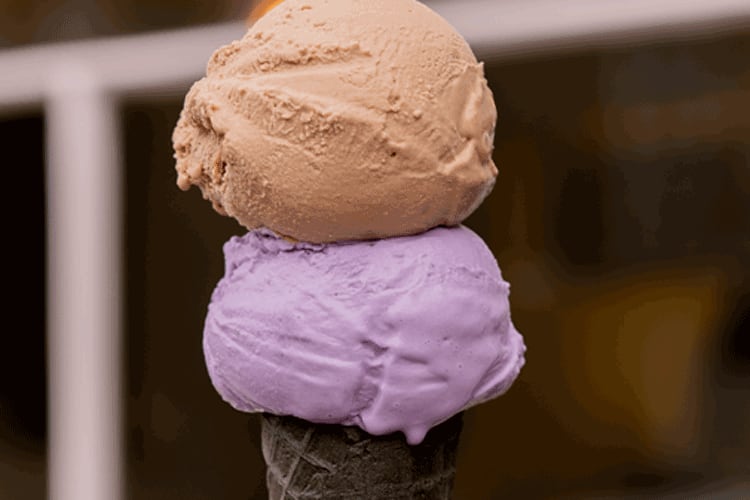
Hitting a purple patch
Those familiar with the ensuing queues and the Instagram hit of Mamason’s striking purple ice cream cones and bilogs - pandasal milk bread toasted ice cream sandwiches - might be surprised to hear that the concept was not an instant hit. But then again maybe not; an ice cream parlour serving hitherto unknown ingredients (on these shores at least) on a north London street between Kentish Town station and Camden Market doesn’t sound like a recipe for success.
“It was a big risk,” recalls Mae. “Our goal was to introduce Filipino food through dessert, and we only had four flavours at the time: ube (Filipino yam, pronounced ooh-beh), calamansi (Filipino lime), guyabano (custard apple) and Milo (chocolate malt). There was no chocolate, no vanilla and a lot of doubters.
Everyone was a bit cautious to try something that was bright purple and potato – they were a bit confused. “We lost a lot customers asking for chocolate and vanilla. It was disheartening in the first few weeks that people didn’t want to try or understand it.”
Undeterred, and spurred on by the popularity of dessert brands such as Bubblewrap, Chin Chin Labs and Yolkin, they persevered. “Dining out was becoming a bit more European, it was at a time when people went and queued up at places just for dessert,” adds Mae. “I took Omar to a Yolkin pop up and the queue was insane. It encouraged us to go forward with Mamasons and do other Filipino desserts other than just ice cream.”
Initially a hard sell, Mae took to being on the counter almost telling the history of the Philippines to every customer who showed interest in the products. After her spiel she says people felt obliged to try it, and once they did, they loved it. Its unique proposition attracted a core group of foodies and social media hypebeasts and the concept flew.
"We are trying to make ube
as popular as matcha"
Absolute confirmation that the pair were onto a winner with Mamasons came a year later when Shaftesbury came knocking to offer them Chinatown for their second site. Located on ‘dessert alley’ alongside Asian dessert brands such as Kova Patisserie, Taiyakiya and Guo C 100, it was a mouth-watering but equally scary proposition for the pair.
“We come from neighbourhoods where you do a spit handshake deal with a landlord, but this was different. Chinatown was the big nosebleed rent but Shaftesbury were great. It was expensive but there were shops surviving there so we said we’d take a look,” says Omar who, with Mae, visited the area and stood outside shops with a clicker counting footfall. “That told us that even on a conservative level we would still be able to make it work.”
A few years later and the pair found themselves doing the same again, this time at Westfield London, where they were offered a prime location within the shopping centre. This time, put off by the expense of the project, the pair turned the offer down. It would eventually take two years of negotiations - not helped by the Covid pandemic - to get the deal over the line.
“It was nerve-racking,” says Mae. “Every time we do a site it is important that it is impactful in our goal of introducing Filipino food through dessert and making sure lots of London areas can experience it. But we are trying to make ube as popular as matcha, and in somewhere like Westfield you can do that.”
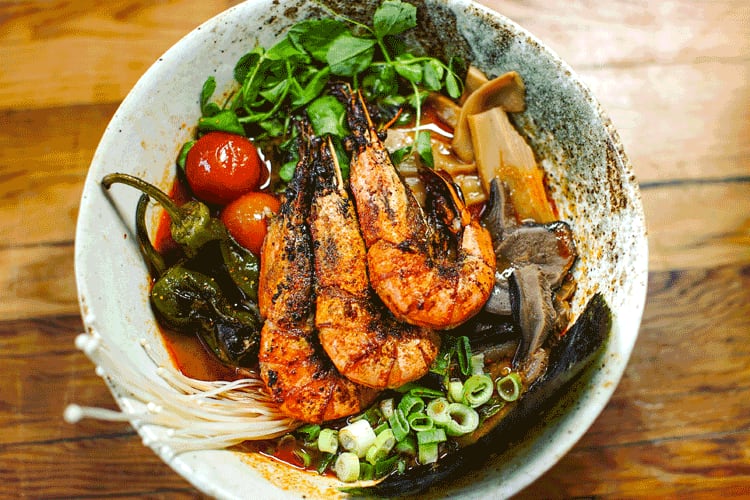
Ramen with a twist
With a number of different restaurant concepts under their belts, including a dessert brand that had captured Londoners’ imaginations, this would seem like a logical time to for the couple to stop and take stock. But even while Mamasons Chinatown was coming to fruition Omar and Mae were already concocting yet another restaurant concept in Ramo Ramen, a brand that takes inspiration from the growth in the ramen category in the capital while staying true to the restaurant group’s halal roots and its Filipino leaning.
“I introduced ramen to Bintang in 2009 and was obsessed with it,” says Omar. “Every time someone ordered it all the chefs would curse me in their heads because they all had to stop, take out the broth and special noodles and toppings and all surround this one bowl. It was delicious but too much effort for a kitchen not designed to do it, so I promised myself if I ever opened another restaurant, it would be a ramen one.”
While noodle soup dishes do exist in the Philippines, they are not made with broths cooked for days on end as in Japan and are typically thickened with corn starch. Instead, Ramo Ramen wanted to take the disciplines of tonkotsu making but use beef, lamb and chicken rather than pork as the basis for the broth and then add distinctly Filipino flavours. In many cases, dishes were created by trial and error with Omar routinely adding items from the menu at Bintang to bowls of broth and noodles to see what worked.
“We already had a chicken noodle dish at Bintang and our oxtail kare kare was very popular there. I was making a broth and I accidentally added my kare kare, which is traditionally served with rice, to the ramen and it was great. I was looking for something that would stand up against a tonkotsu broth and the gelatine you get from oxtail is perfect for this.”
On the face of it, ramen with a Filipino twist sounds like committing culinary suicide; at once alienating Filipinos seeking the authentic home cooking of their parents and grandparents and the legion of purists for which a slowly boiled tonkotsu broth is an art form. Yet Ramo Ramen has numerous things going for it, not least its point of difference, the fact that Filipino cuisine has historically been a melting pot of geographical influences, and that people - Londoners in particular - are open to trying new things.
“Every other ramen restaurant is offering tonkotsu broths, but this gives ramen heads something different and also allows people who don’t eat pork and who wouldn’t normally step into a ramen restaurant to try it,” says Omar. “You can take more risks and be more in control of its success these days. People who have an Instagram account want something new to put on it, so they make that journey and take that risk. You can see that by the queues round the block for Korean corn dogs.”
“Filipino food is fusion food – a lot of it is inspired by other countries,” adds Mae. “Of all the things that we have done this has been the easiest to communicate to our customers.”
A second Ramo Ramen opened in Soho last year, giving the pair the chance to try new things. While there are menu similarities, the Soho ramen shop has a larger smaller plates selection, including scallops; a lobster and crab ginataan, and a wagyu steak donburi as well as a cocktail programme. On the Kentish Town menu is a lamb tantanmen ramen made with Bangladeshi lime that Omar says was created to keep his father happy.
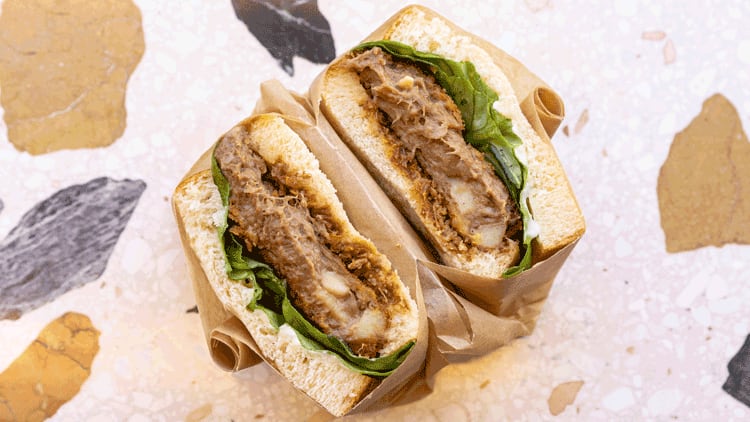
Making more dough
The pair have not stopped there. Last year also saw the opening of their Filipino bakery that replaced a dining room area of Guanabana that had its own shop front. Called Panadera, which translates as female baker (Mae named it after her mum because Omar named Mamasons after his mum and she got jealous) the new brand was created to add value to their Kentish Town estate as well as supply Mamasons with breads for its biloks.
“The main reason we opened Panadera was that Westfield has a very rigid system, we had to be able to produce x amount of products there a day,” says Mae. “They told us that this was how busy we were going to be and that we could not run out of anything - it’s part of our contract that we can’t close. That’s a big thing for us because in Chinatown we sell out and that’s OK.”
True to form, Panadera has taken on a life of its own and has become known for its baked goods, such as the traditional Filipino pandesal bread and sandwiches, with its corned beef hash sando (pictured above) garnering almost as much interest as its purple ice cream sandwiches.
Panadera now also plays a pivotal role in the company’s future. As a central bakery it is used to make burger buns (they previously bought in brioche buns) and garlic bread for Ramo Ramen as well as bread for Mamasoms.
“We are leveraging the bakery and also making ice cream for every restaurant,” says Omar. “At Ramo we now make marinades for the other restaurants. When we create a dish, we don’t magic it out of nowhere but look at what we can leverage to make something special and original. Every restaurant has its superpower, and we will use that superpower for the other places. And Panadera has the biggest power right now.”
“We have been very hands on. We now
need to take a step back, but it’s
very hard for us to let go"
This power is not to be underestimated. Of all of its very popular brands, Panadera is the strongest in terms of demand, with the pair having received numerous offers to open in the Middle East. While they would like to open more bakeries in the capital – a concession in the Tate being a particular dream - if they move Panadera beyond the capital it is likely to be much further afield, with New York on their bucket list.
Whether Ramo Ramen can work outside of London is moot. While Omar acknowledges that once the ramen process is perfected it becomes quite systematic and scalable, he’s not convinced the Filipino twist has much mileage beyond the capital. “You wouldn’t get this out of London,” he insists. “It’s Filipino Japanese food but it’s predominately a London cuisine.”
Mae has more conviction and says that, based on the popularity of the at-home ramen kits created for lockdown from people in places such as Birmingham and Manchester, there could be scope for some sort of national presence. “The interest is there,” she insists.
Could they launch yet another brand? “The theory of creating a concept is something that we do every other day,” says Mae with a laugh. “Creating brands and space is our strength. I would love to speak to JKS and pick their brains. To me they are unspoken heroes to see what they’ve done - watching them grow gave us the confidence to try out new things.”
In the immediate future, however, the pair are turning their attention to processes. “Where do we go from here? At this point we want to invest more in our organisational structure, process and systems and bring people on board to help us with that,” says Omar.
“We have been very hands on. We now need to take a step back, but it’s very hard for us to let go. But we have to because it’s to the detriment of the business if we don’t. If we don’t take a wider approach to our business, we are going to miss a trick.”
One thing they won’t step back from is their long-held desire for Filipino ice cream to properly break through into the mainstream, not just in London but nationwide.
“We want to sell it from our shops and see how far we can take that,” says Omar. “Our dream is for people to have Filipino ice cream in their household freezers, so instead of a tub of Häagen-Dazs they have Mamasons. That would be really cool.”
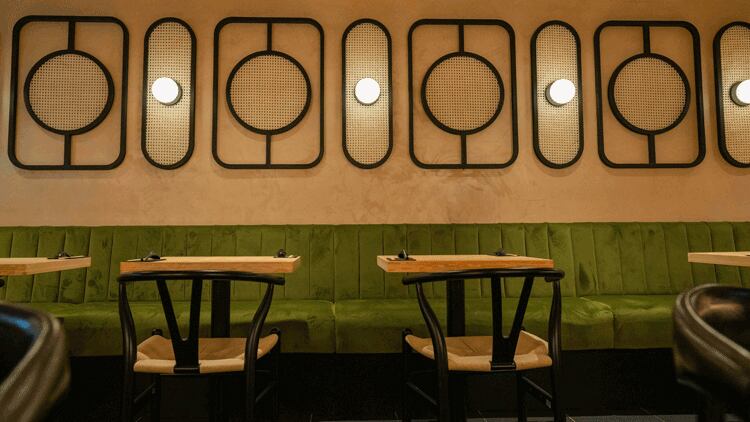
The Maginhawa method
With nine restaurants across six brands, Maginhawa Group operates a diverse mini-empire in the capital.
Bintang
Opened in 1987, Bintang is one of London’s first pan-Asian restaurants. The restaurant has gradually increased its range of Filipino dishes since coming into the Maginhawa group, with menu items that include silogs - Filipino breakfast skillets made with fried eggs and rice.
Guanabana
The Latin America and Caribbean restaurant opened next door to Bintang in 2008 in a former kebab shop and is described as the first halal restaurant of its kind in the capital. The BYOB restaurant specialises in cuisine from all over South America the Caribbean, including Jamaica, Colombia, Mexico, with dishes such as jerk chicken, curry lamb, beef ribs and oxtail butter bean stew.
Mamasons
London’s first Filipino ice cream parlour opened in Kentish Town in 2017 in a former massage parlour and now operates two further sites, in Chinatown and Westfield London in White City. Known for its vibrant ice creams made with ube (purple yam) and ice cream sandwiches called bilogs it quickly became an internet sensation among foodies. Other menu items include an ube spiced latte, and Halo Halo - shaved ice evaporated milk with cconut strings, jellies, leche flan and ube ice cream.
Panadera
Filipino bakery Panadera opened in 2021, taking over the one of the dining room spaces of Bintang that had its own shop front. It serves a range of sweet and savoury baked goods to the people of Kentish Town. Sweet items include ube pie and calamansi meringue while savoury ones include its corned beef hash sando, panko chicken and mushroom sando, and egg and truffle sando. The bakery also makes pandesal - a traditional Flipino milk bun - and supplies baked goods to the group’s other restaurants.
Ramo Ramen
Following the success of the original Ramo Ramen, which opened in Kentish Town in 2018, Maginhawa Group now operates two of its Filipino Japanese ramen bars with a second one now open in Soho. The brand is known for its delightfully unauthentic non-pork ramen and proved it can mix it with the capital’s finest noodle soup purveyors when it won Timeout London and Deliveroo’s Battle of the Broths in 2018, going up against five other ramen and pho vendors.
Moi Moi Island
The takeaway spin-off to Guanabana that focuses on West African and Caribbean cuisine. The menu comprises a number of food bowls served in aluminium trays, including suya beef with jollof rice; jerk chicken with rice and peas, fried plantain, and jerk gravy salad; lamb curry stew; and chickpea stew with jollof rice, okra and callaloo, as well as wings, salads, fried and mac and cheese.


